Abstract
Direct visualization of the biliary tree using choledochoscopy has been recommended as a technique to improve the accuracy of common duct exploration. In several series the incidence of retained biliary calculi has been dramatically reduced using choledochoscopy, and some authors have reported the findings of other unsuspected benign and malignant lesions as well. During an eight-year period 288 patients underwent exploration of the common bile duct specifically for calculous disease. Operative rigid choledochoscopy was performed in 140 patients in this group, with 79 found to have choledocholithiasis; seven retained stones occurred in this group for an incidence of 8.9%. Routine common duct exploration in the other 148 patients revealed 67 to have choledocholithiasis; six retained stones occurred in this group for an incidence of 9.0%. Though there was no difference in the incidence of retained stones with or without choledochoscopy, 20 patients were found to have stones missed during routine exploration once the rigid choledochoscope was inserted. In addition to the obvious value of the choledochoscope in identifying and removing common duct stones, it was also found to be an aid in removing stones in the intra-hepatic ducts and in clarifying atypical anatomy. Other causes of biliary obstruction such as a liver fluke, benign polyp, benign strictures, and ductal carcinomas were identified by use of biopsy forceps inserted through the choledochoscope. It is recommended that routine choledochoscopy be performed during common duct explorations and that surgical training programs insure that residents learn the technique of operative choledochoscopy.
Full text
PDF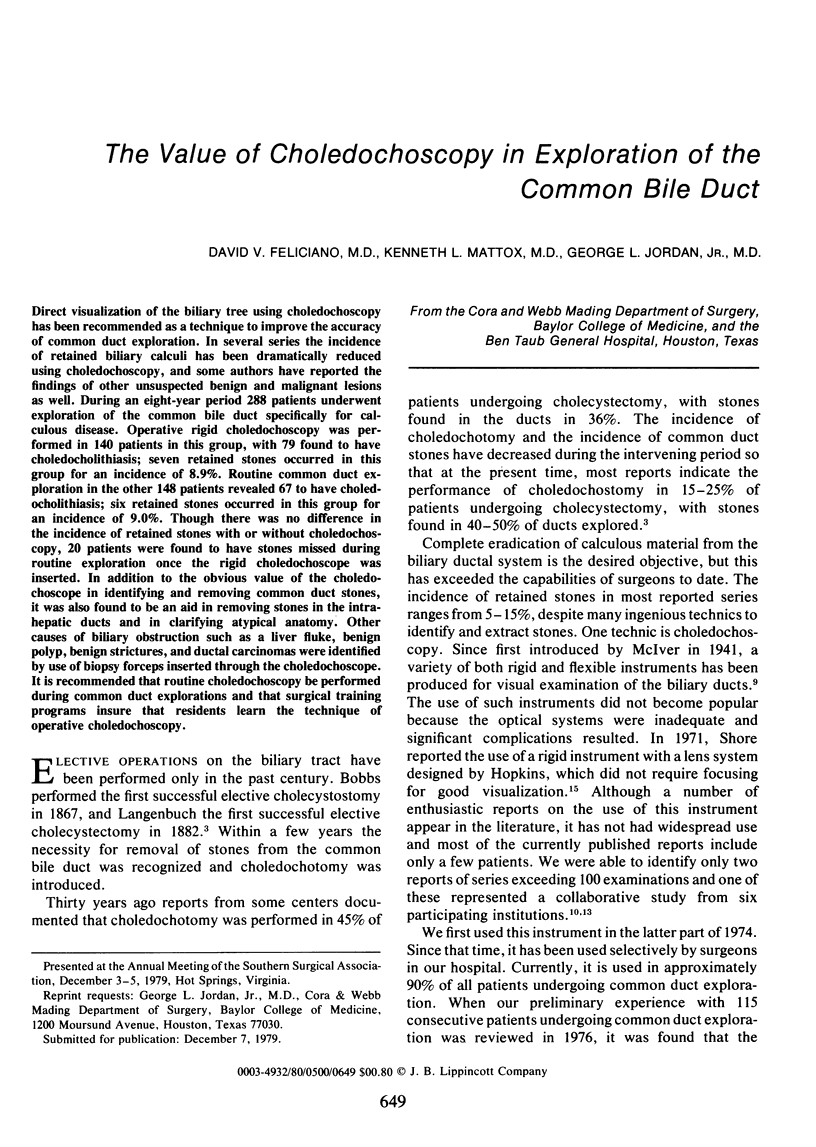
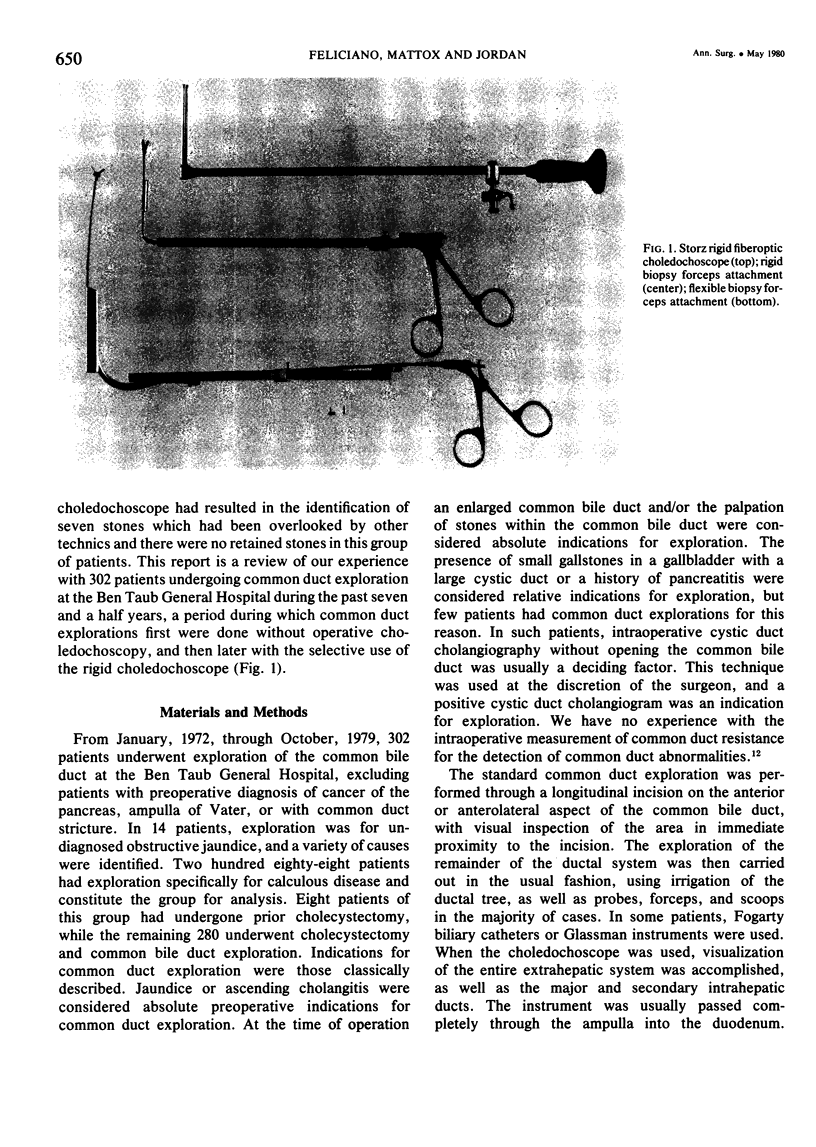
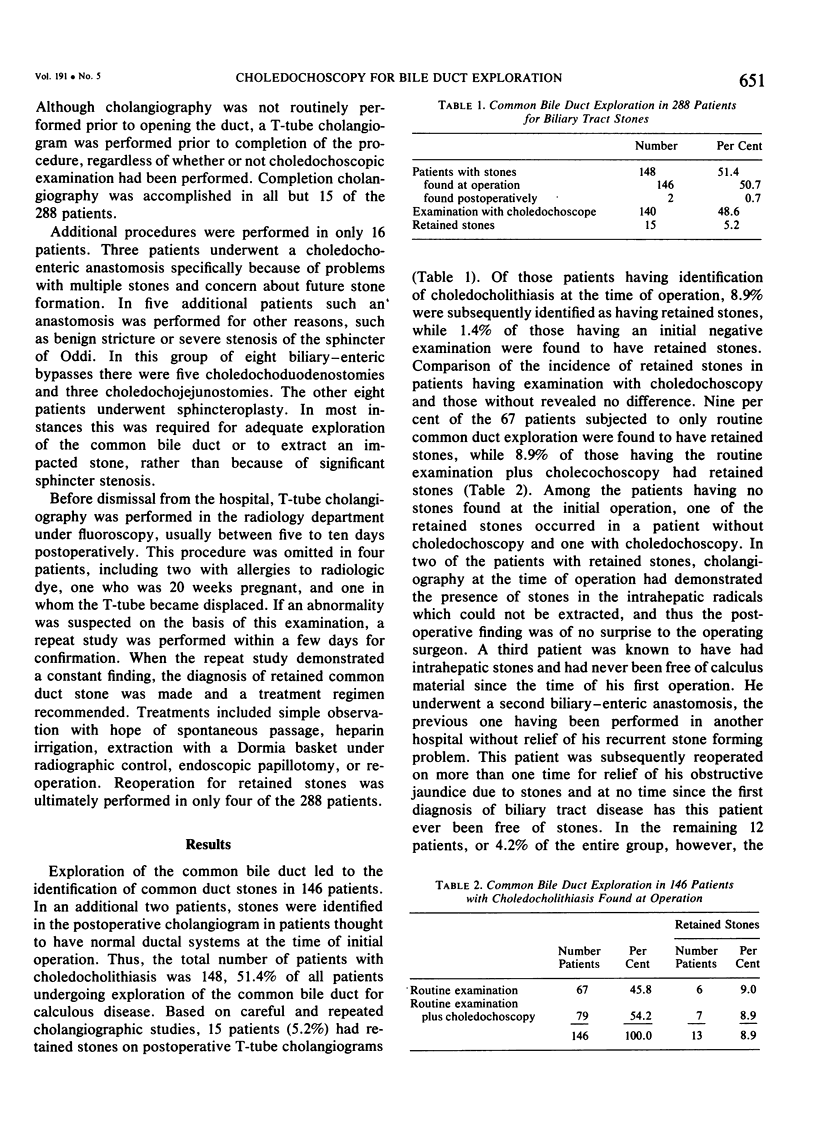
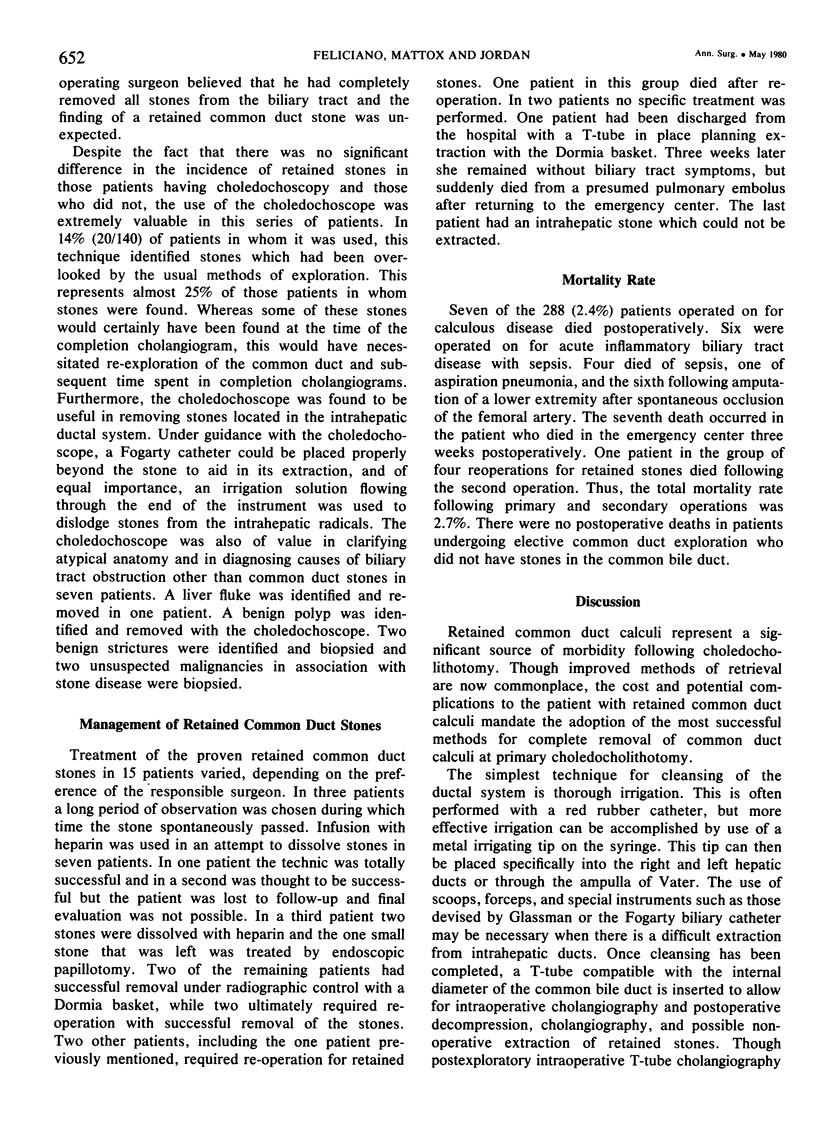
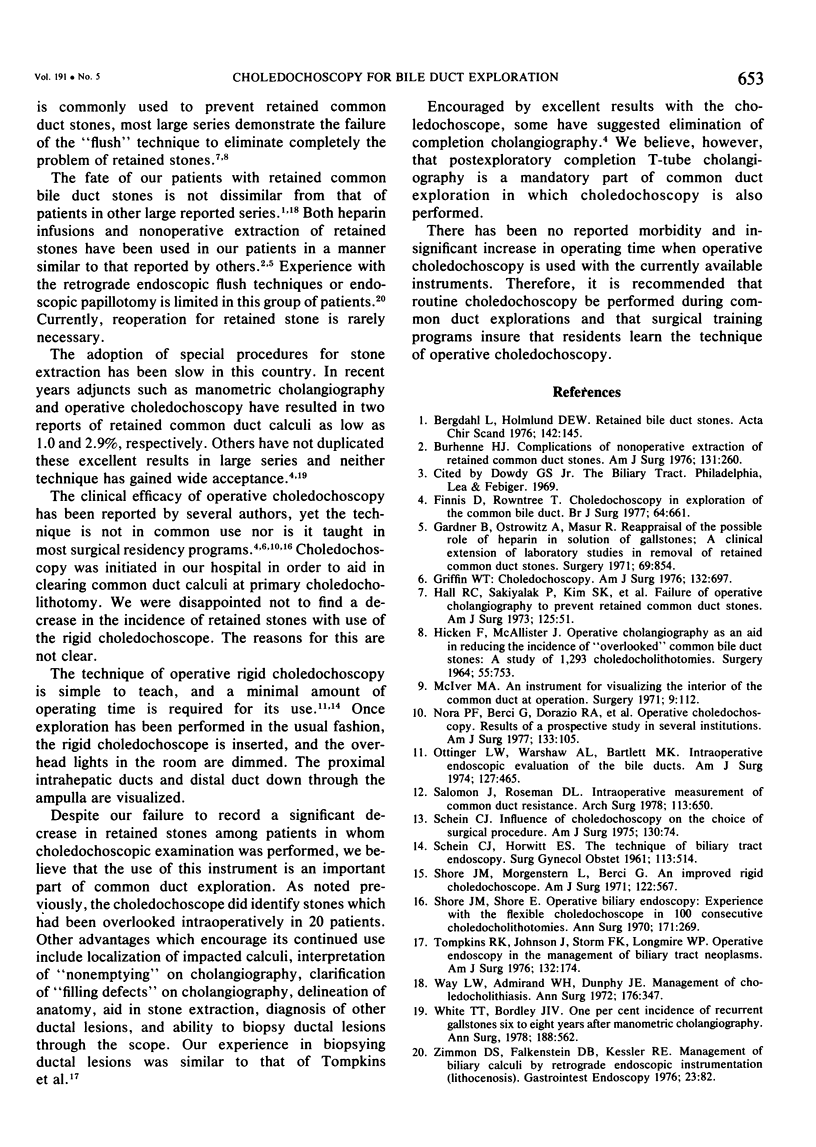
Images in this article
Selected References
These references are in PubMed. This may not be the complete list of references from this article.
- Bergdahl L., Holmlund D. E. Retained bile duct stones. Acta Chir Scand. 1976;142(2):145–149. [PubMed] [Google Scholar]
- Burhenne H. J. Complications of nonoperative extraction of retained common duct stones. Am J Surg. 1976 Mar;131(3):260–262. doi: 10.1016/0002-9610(76)90111-2. [DOI] [PubMed] [Google Scholar]
- Finnis D., Rowntree T. Choledochoscopy in exploration of the common bile duct. Br J Surg. 1977 Sep;64(9):661–664. doi: 10.1002/bjs.1800640916. [DOI] [PubMed] [Google Scholar]
- Gardner B., Ostrowitz A., Masur R. Reappraisal of the possible role of heparin in solution of gallstones: a clinical extension of laboratory studies in removal of retained common duct stones. Surgery. 1971 Jun;69(6):854–857. [PubMed] [Google Scholar]
- Griffin W. T. Choledochoscopy. Am J Surg. 1976 Dec;132(6):697–698. doi: 10.1016/0002-9610(76)90437-2. [DOI] [PubMed] [Google Scholar]
- HICKEN N. F., MCALLISTER A. J. OPERATIVE CHOLANGIOGRAPHY AS AN AID IN REDUCING THE INCIDENCE OF "OVERLOOKED" COMMON BILE DUCT STONES: A STUDY OF 1,293 CHOLEDOCHOLITHOTOMIES. Surgery. 1964 Jun;55:753–758. [PubMed] [Google Scholar]
- Hall R. C., Sakiyalak P., Kim S. K., Rogers L. S., Webb W. R. Failure of operative cholangiography to prevent retained common duct stones. Am J Surg. 1973 Jan;125(1):51–63. doi: 10.1016/0002-9610(73)90008-1. [DOI] [PubMed] [Google Scholar]
- Nora P. F., Berci G., Dorazio R. A., Kirshenbaum G., Shore J. M., Tompkins R. K., Wilson S. D. Operative choledochoscopy. Results of a prospective study in several institutions. Am J Surg. 1977 Jan;133(1):105–110. doi: 10.1016/0002-9610(77)90202-1. [DOI] [PubMed] [Google Scholar]
- Ottinger L. W., Warshaw A. L., Bartlett M. K. Intraoperative endoscopic evaluation of the bile ducts. Am J Surg. 1974 Apr;127(4):465–468. doi: 10.1016/0002-9610(74)90298-0. [DOI] [PubMed] [Google Scholar]
- SCHEIN C. J., HURWITT E. S. The technique of biliary tract endoscopy. Surg Gynecol Obstet. 1961 Oct;113:514–516. [PubMed] [Google Scholar]
- Salomon J., Roseman D. L. Intraoperative measurement of common duct resistance. Arch Surg. 1978 May;113(5):650–653. doi: 10.1001/archsurg.1978.01370170112024. [DOI] [PubMed] [Google Scholar]
- Schein C. J. Influence of choledochoscopy on the choice of surgical procedure. Am J Surg. 1975 Jul;130(1):74–77. doi: 10.1016/0002-9610(75)90461-4. [DOI] [PubMed] [Google Scholar]
- Shore J. M., Morgenstern L., Berci G. An improved rigid choledochoscope. Am J Surg. 1971 Oct;122(4):567–568. doi: 10.1016/0002-9610(71)90492-2. [DOI] [PubMed] [Google Scholar]
- Shore J. M., Shore E. Operative biliary endoscopy: experience with the flexible choledochoscope in 100 consecutive choledocholithotomies. Ann Surg. 1970 Feb;171(2):269–278. doi: 10.1097/00000658-197002000-00016. [DOI] [PMC free article] [PubMed] [Google Scholar]
- Tompkins R. K., Johnson J., Storm F. K., Longmire W. P., Jr Operative endoscopy in the management of biliary tract neoplasms. Am J Surg. 1976 Aug;132(2):174–182. doi: 10.1016/0002-9610(76)90044-1. [DOI] [PubMed] [Google Scholar]
- Way L. W., Admirand W. H., Dunphy J. E. Management of choledocholithiasis. Ann Surg. 1972 Sep;176(3):347–359. doi: 10.1097/00000658-197209000-00011. [DOI] [PMC free article] [PubMed] [Google Scholar]
- White T. T., Bordley J., 4th One per cent incidence of recurrent gallstones six to eight years after manometric cholangiography. Ann Surg. 1978 Oct;188(4):562–569. doi: 10.1097/00000658-197810000-00013. [DOI] [PMC free article] [PubMed] [Google Scholar]
- Zimmon D. S., Falkenstein D. B., Kessler R. E. Management of biliary calculi by retrograde endoscopic instrumentation (lithocenosis). Gastrointest Endosc. 1976 Nov;23(2):82–86. doi: 10.1016/s0016-5107(76)73597-1. [DOI] [PubMed] [Google Scholar]



